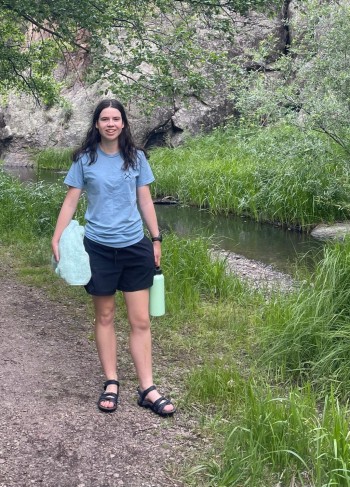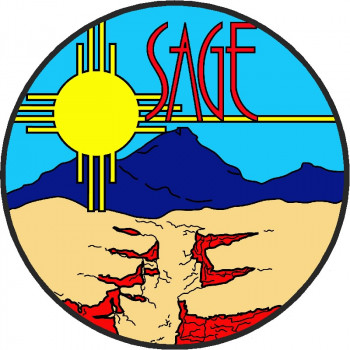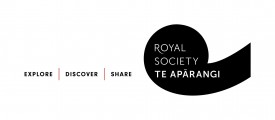 2025 New Zealand SAGE Award winner:
2025 New Zealand SAGE Award winner:
Georgina Dempster
University of Otago master’s student Georgina Dempster has just returned from a summer research trip to the U.S. and is excited to use what she learned towards her study of New Zealand’s Alpine Fault.
Her trip was funded through the Summer of Applied Geophysical Experience (SAGE) scholarship, funded by Natural Hazards Commission Toka Tū Ake and Geoscience Society of New Zealand.
“It was a great opportunity to get experience using geophysical methods that we don’t have here in New Zealand, as well as to meet people across a range of careers to find out what they’re up to and how they got there, which gave me ideas for where my degree can take me,” says Georgina.
SAGE is an international educational programme that connects students with established scientists, industry professionals and government researchers to collaborate on short research projects at Valles Caldera in Sante Fe, New Mexico.
The giant Valles Caldera is an imposing landscape which was formed 1.2 million years ago following an ancient volcanic eruption. Today, it provides geologists with the perfect open-air laboratory for studying natural processes.
Georgina’s team packed a lot of work into their two-and-a-half-week trip, including field work, a geological field trip, data processing, and group presentations. To save time getting to and from the site, the team camped at the Caldera.
“Camping was really fun, we played lots of Uno and other card games, there were a couple of trails near the campsite, we lit a campfire and had s’mores.”
Georgina is excited to be home and applying what she’s learned to her research into the Alpine Fault’s tectonic history, under supervisors Profs Andrew Gorman and Sean Fitzsimons. Georgina is studying changes in landscape at Lake Wakatipu in Queenstown since the last ice age, 18,000 years ago.
“I like the idea of looking underneath the ground and lake surfaces to learn about the past and think about what it tells us about the future.”
The relationships, fieldwork experience and various geophysical methods Georgina got to try through SAGE will help her in her master’s research as well as in deciding what she wants to do next in her career.
“I really enjoyed the fieldwork part of SAGE. It was really cool working in the Valles Caldera, deploying different instruments and collecting our own data in new areas that hadn’t been studied before. The fieldwork had the added bonus of being able to see coyotes, elk, and prairie dogs.”
This story was originally published by the Natural Hazards Commission Toka Tū Ake
Past New Zealand SAGE Award winners
| Year | Person | University |
| 2020 | Tayla Hill | Otago |
| 2019 | Laura Hughes | Victoria |
| 2018 | Clarrie Macklin | Victoria |
| 2017 | Not awarded | - |
| 2016 | Sam Taylor-Offord | Victoria |
| 2015 | Ashleigh Fromont | Auckland |
| 2014 | Ben Ross | Otago |
| 2013 | Anton Gulley | Auckland |
| 2012 | Not awarded | - |
| 2011 | Richard Davy | Victoria |
| 2010 | Katharina Unglert | Victoria |
| 2009 | Not awarded | - |
| 2008 | Jessica Johnson | Victoria |
| 2007 | Not awarded | - |
| 2006 | Not awarded | - |
| 2005 | Anna Leslie | Otago |
| 2004 | Not awarded | - |
| 2003 | Emma Davies | Canterbury |
| 2002 | Michelle Salmon | Victoria |
| 2001 | Huw Horgan | Victoria |
| 2000 | Michael Finnemore | Canterbury |
New Zealand SAGE Award
The Summer of Applied Geophysical Experience (SAGE), is a unique ‘hands-on' geophysical educational programme held yearly over a four-week period in June/July in New Mexico. It is conducted by the Los Alamos National Laboratory, a Branch of the Institute of Geophysical and Planetary Physics, University of California.
SAGE aims to enhance the experience and knowledge of students of geophysics in an intense course of geophysical exploration and research that goes beyond classroom-based curricula. Much more than just a summer field camp, SAGE is a complete immersion in geophysics, an educational experience in which students participate in every phase of the field and interpretation programmes.
SAGE participants are chosen globally, and since 2001 one enrolment to participate in SAGE has been available to a student from New Zealand.
Funding for the New Zealand SAGE Award is provided by the Geoscience Society of New Zealand and the Natural Hazards Commission Toka Tū Ake.

